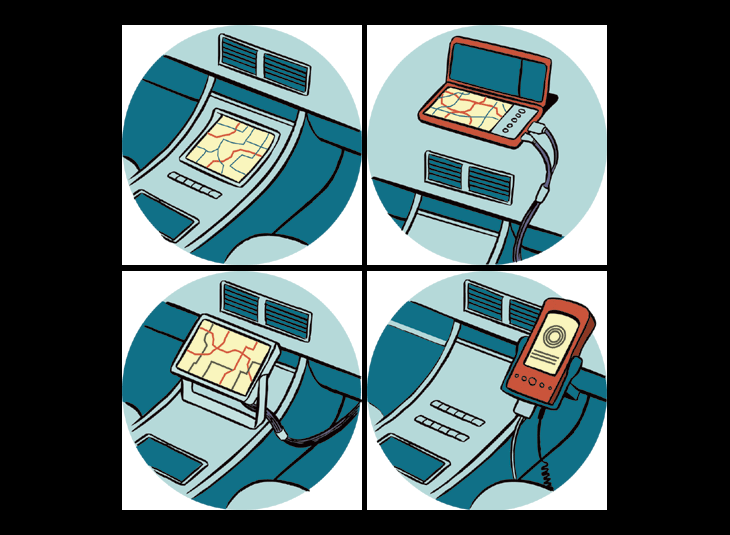

Dept: Geek Guide
Tech: Automotive GPS
Cost: $200-$2,500
BETA | | | | | FINAL
No question, GPS has revolutionized travel–navigation aboard airplanes is now virtually child’s play, hikers have no excuse for getting lost, and traveling salespeople can cover more ground faster–but do you, Joe Driver, really need satellites beaming coordinates to your dashboard?
For your day-to-day life, probably not. You know where work and home are, and you can get yourself to the mall just fine, thank you very much. But if you visit new places with any regularity, automotive navigation will make even the occasional road trip a lot easier.
GPS systems are still relatively expensive, so first ask yourself what you really need. (Trust me, the excitement of colorful moving maps and chatty female-voiced computers wears off in about a week.) Expensive units offer more detailed screens, faster route calculations, and extras like voice command, but even the most basic models will tell you precisely where you are and how to get somewhere else. Take a look at the options that follow and “Buying Advice” below, then hit the road.
Four Ways to Find Yourself
1) Factory-installed These systems are by far the most powerful devices available. Because they are hardwired into your car, they can tap into the speedometer and use electronic gyroscopes to determine where and how fast you’ve traveled. That permits continued tracking in dense urban environs, mountains and heavily forested country, where satellite reception might be spotty. Another thing that’s unique to factory systems is that they often provide access to your car’s other functions (radio, climate controls) through the same interface. This is particularly useful on an intuitive touchscreen like the one Lexus uses. It’s not as helpful on insanely complicated dial-controls like BMW’s iDrive. (Audi’s flagship A8 has a far smarter dial control.) $1,750 to $2,500–option on new-car purchases
2) Aftermarket Many of these units offer functions similar to factory-installed hardware, and a few have distinctive extras–Blaupunkt’s TravelPilot DX-V, for example, plays DVDs–but expect some visible evidence that they’re aftermarket. Retractable screens might sit wobblingly on hinged mounts, thumb controls strapped to the steering wheel take some getting used to, and you may have little antennas and wireless transmitter pods positioned in odd places around the car. Don’t expect these systems to add much to your resale value. $1,250 to $2,000, plus $150 to $300 for installation
3) Portable If you have more than one vehicle or often find yourself in rental cars, these are a fine compromise. While not as robust as factory units, they are economical–gray-scale units start at around $500–and offer the same map, routing and voice-command functions as the bigger units. Compact and not permanently attached, they leave the car when you do, or hide in the trunk. While new units from Magellan (RoadMate 700/500) and Garmin (StreetPilot 2610) have nationwide base maps built in, memory limitations on other models require you to upload map data from your PC. $500 to $1,200
4) PDA-based Garmin’s iQue 3600 is the clear leader among the PDA-based units, with a built-in GPS antenna and an exceptionally well developed user interface in the mapping mode. It comes with a simple but reliable bean-bag mount to stabilize it on the dashboard. Other PDA-based units require antenna attachments and come with a confusing array of cables and adapters to attach the unit to your dashboard, usually by inserting plastic tabs into air vents. And note that PDA units are by far the hardest to operate while driving, especially when a stylus is involved. $200 to $500
Buying Advice
Using Your System